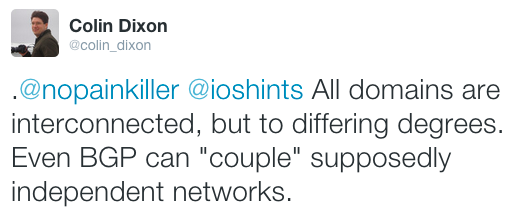Category: BGP
Introduction to BGP-LS and PCEP
Julian Lucek did a fantastic job describing how NorthStar controller uses BGP-LS and PCEP, so I asked him whether he’d be willing to do a deep dive on these two topics. He gracefully agreed, and the results are already online.
Video: Simplify Network Configurations with Cumulus Linux
Many vendors talk about network automation these days, and almost all of them gloss over an important detail: automation works best when you manage to simplify things to the bare minimum needed to get the job done.
One of the vendors that focus on simplifying the network device configuration is Cumulus Linux.
Project Calico: Is It Any Good?
At least a dozen engineers sent me emails or tweets mentioning Project Calico in the last few weeks – obviously the project is getting some real traction, so it was high time to look at what it’s all about.
TL&DR: Project Calico is yet another virtual networking implementation that’s a perfect fit for a particular use case, but falters when encountering the morass of edge cases.
LDP Label Allocation Revisited
One of my readers was having an LDP argument with his colleague:
Yesterday I was arguing with someone who works for a large MPLS provider about LDP label allocation. He kept saying that LDP assigns a label to each next-hop, not to each prefix. Reading your blog, I believe this is the default behavior on Juniper but on Cisco LDP assigns a unique label for each IGP (non-BGP) prefix.
He’s absolutely right; Cisco and Juniper use different rules when allocating MPLS labels.
On SDN Controllers, Interconnectedness and Failure Domains
A long long time ago Colin Dixon wrote the following tweet in response to my Controller Cluster Is a Single Failure Domain blog post:

He’s obviously right, but I wasn’t talking about interconnected domains, but failure domains (yeah, I know, you could argue they are the same, but do read on).
Reducing BGP SNMP Traps in DMVPN Networks
One of my readers decided to build an extensive DMVPN network with BGP as the WAN routing protocol (good choice!) and configured BGP SNMP traps with snmp-server enable traps bgp command on the hub router to detect spoke router failures. It turns out that’s not exactly a good idea.
Estimating BGP Convergence Time
One of my readers sent me this question:
I have an Internet edge setup with two routers connected to two upstream ISPs and receiving full BGP routing table from them. I’m running iBGP between my Internet routers. Is there a formula to estimate convergence time if one of my uplinks fail? How many updates will I need to get the entire 512K routes in BGP table and also how much time it would take?
As always, the answer is it depends.
BGP Configuration Made Simple with Cumulus Linux
BGP is without doubt the most scalable routing protocol, which made it a popular choice for large-scale deployments from service provider networks to enterprise WAN/VPN networks and even data centers. Its only significant drawback is the tedious configuration process (which almost reminds me of writing COBOL programs decades ago).
RFC 7454: BGP Operations and Security
After almost exactly three years of struggles our BGP Operations and Security draft became RFC 7454 – a cluebat (as Gert Doering put it) you can use on your customers and peers to help them fix their BGP setup.
Without Jerome Durand this document would probably remain forever stuck in the draft phase. It’s amazing how many hurdles one has to jump over to get something published within IETF. Thanks a million Jerome, you did a fantastic job!
BGP Deaggregation with Conditional Route Injection
Whenever there’s a weird request to do something totally illogical with BGP, there’s a knob in Cisco IOS to get it done (and increase the heartburn of CCIE candidates). Conditional Route Injection (the ability to insert more specific prefixes into BGP without having them in the IP routing table) is one of them.
Keep in mind: being a MacGyver is not a long-term strategy. Just because you can doesn’t mean that you should.
Can You AS-Prepend a Single Host Route?
Someone recently sent me this question:
Is it possible to prepend one IP address from a public IPv4 segment?
I don’t want to know what crazy stunt this engineer was forced to pull off, but just in case you land in a similar quandary here’s how you shoelace yourself out of it.
FECs, LDP, and BGP in the MPLS World
After discussing the basics of MPLS and LDP in our chat, Seamus Gilchrist and myself focused on a concept that perplexes many networking engineers entering the MPLS world: the relationship between Forward Equivalence Classes (FEC), LDP and BGP.
heBorder6 Non-Stop Internet: a Commercial BGP-Based SDN
Several SDN solutions that coexist with the traditional control- and data planes instead of ripping them out and replacing them with the new awesomesauce use BGP to modify the network’s forwarding behavior.
Border6 decided to turn that concept into a commercial product that we dissected in Episode 12 of Software Gone Wild podcast.
Enjoy the show (this time in video format).
… updated on Tuesday, February 28, 2023 17:46 UTC
The Four Paths to SDN
After the initial onslaught of SDN washing, four distinct approaches to SDN have started to emerge, from centralized control plane architectures to smart reuse of existing protocols.
As always, each approach has its benefits and drawbacks, and there’s no universally best solution. You just got four more (somewhat immature) tools in your toolbox. And now for the details.
Fate Sharing in IP Networks
My good friend Tiziano complained about the fact that BGP considers next hop reachable if there’s an entry in the IP routing table even though the router cannot even ping the next hop.
That behavior is one of the fundamental aspects of IP networks: networks built with IP routing protocols rely on fate sharing between control and data planes instead of path liveliness checks.
